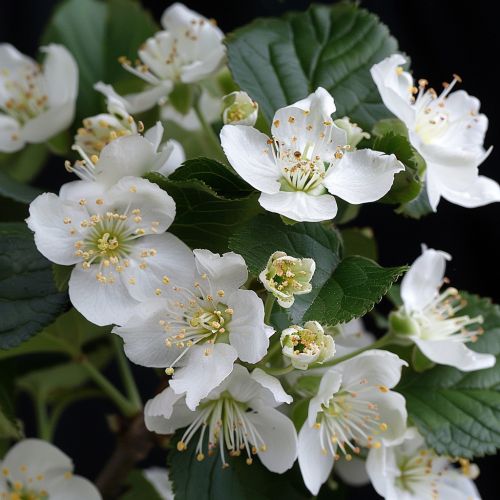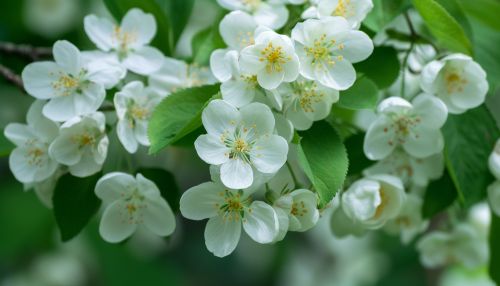Crataegus laevigata: Difference between revisions
(Created page with "== Description == <div class='only_on_desktop image-preview'><div class='image-preview-loader'></div></div><div class='only_on_mobile image-preview'><div class='image-preview-loader'></div></div> '''Crataegus laevigata''', commonly known as the Midland hawthorn or English hawthorn, is a species of hawthorn native to western and central Europe. It is a deciduous tree or shrub belonging to the family Rosaceae. This species is notable for its dense clusters o...") |
No edit summary |
||
| Line 1: | Line 1: | ||
== Description == | == Description == | ||
[[Image:Detail-91575.jpg|thumb|center|A close-up photograph of Crataegus laevigata in bloom, showing its white flowers and green leaves.|class=only_on_mobile]] | |||
[[Image:Detail-91576.jpg|thumb|center|A close-up photograph of Crataegus laevigata in bloom, showing its white flowers and green leaves.|class=only_on_desktop]] | |||
'''Crataegus laevigata''', commonly known as the Midland hawthorn or English hawthorn, is a species of hawthorn native to western and central Europe. It is a deciduous tree or shrub belonging to the family [[Rosaceae|Rosaceae]]. This species is notable for its dense clusters of white or pink flowers and its small, red fruit, known as haws. The tree is often found in hedgerows, woodlands, and scrublands, thriving in a variety of soil types. | '''Crataegus laevigata''', commonly known as the Midland hawthorn or English hawthorn, is a species of hawthorn native to western and central Europe. It is a deciduous tree or shrub belonging to the family [[Rosaceae|Rosaceae]]. This species is notable for its dense clusters of white or pink flowers and its small, red fruit, known as haws. The tree is often found in hedgerows, woodlands, and scrublands, thriving in a variety of soil types. | ||
Latest revision as of 15:21, 20 June 2024
Description


Crataegus laevigata, commonly known as the Midland hawthorn or English hawthorn, is a species of hawthorn native to western and central Europe. It is a deciduous tree or shrub belonging to the family Rosaceae. This species is notable for its dense clusters of white or pink flowers and its small, red fruit, known as haws. The tree is often found in hedgerows, woodlands, and scrublands, thriving in a variety of soil types.
Taxonomy and Nomenclature
The scientific name Crataegus laevigata derives from the Greek word "kratos," meaning strength, which refers to the hardness of the wood, and "laevigata," meaning smooth, which describes the smoothness of the leaves compared to other hawthorn species. The species was first described by the German botanist Johann Heinrich Friedrich Link in the early 19th century.
Morphology
Crataegus laevigata typically grows to a height of 5-12 meters and can live for several hundred years. The bark is grey and smooth when young, becoming fissured with age. The leaves are simple, lobed, and arranged alternately on the branches. They are typically 2-6 cm long, with a glossy upper surface and a paler underside.
The flowers of Crataegus laevigata are hermaphroditic and appear in late spring. They are usually white but can also be pink, with five petals and numerous stamens. The flowers are borne in corymbs, which are dense clusters that can contain up to 20 individual flowers. The fruit, or haws, are small pomes that ripen to a bright red color in the autumn.
Distribution and Habitat
Crataegus laevigata is native to Europe, with a range extending from the British Isles to the Balkans and from southern Scandinavia to northern Spain. It is commonly found in hedgerows, woodlands, and scrublands, often growing alongside other native species such as oak, hazel, and blackthorn.
The species is adaptable to a wide range of soil types, including clay, loam, and sandy soils. It prefers well-drained soils but can tolerate occasional waterlogging. Crataegus laevigata is also tolerant of urban pollution and can be found in city parks and gardens.
Ecological Importance
Crataegus laevigata plays a significant role in its ecosystem. The flowers provide a valuable source of nectar and pollen for a variety of pollinators, including bees, butterflies, and hoverflies. The haws are an important food source for birds and small mammals, particularly during the winter months when other food sources are scarce.
The dense foliage and thorny branches of Crataegus laevigata provide excellent nesting sites for birds and shelter for small mammals. The tree also supports a wide range of invertebrates, including caterpillars, beetles, and spiders, which in turn attract predators such as birds and bats.
Uses and Cultural Significance
Crataegus laevigata has been used for centuries in traditional medicine. The flowers, leaves, and fruit are all used to make herbal remedies, particularly for cardiovascular conditions. The plant is believed to improve blood circulation, reduce blood pressure, and strengthen the heart muscle.
In addition to its medicinal uses, Crataegus laevigata is also valued for its ornamental qualities. It is commonly planted in gardens and parks for its attractive flowers and fruit, as well as its ability to form dense, impenetrable hedges. The wood of Crataegus laevigata is hard and durable, making it suitable for use in tool handles and other small wooden items.
Conservation Status
Crataegus laevigata is not currently considered to be at risk of extinction. It is widespread and common throughout its range, and its populations are stable. However, like many native species, it faces threats from habitat loss, climate change, and the spread of invasive species. Conservation efforts are focused on preserving its natural habitats and promoting the planting of native species in hedgerows and woodlands.
